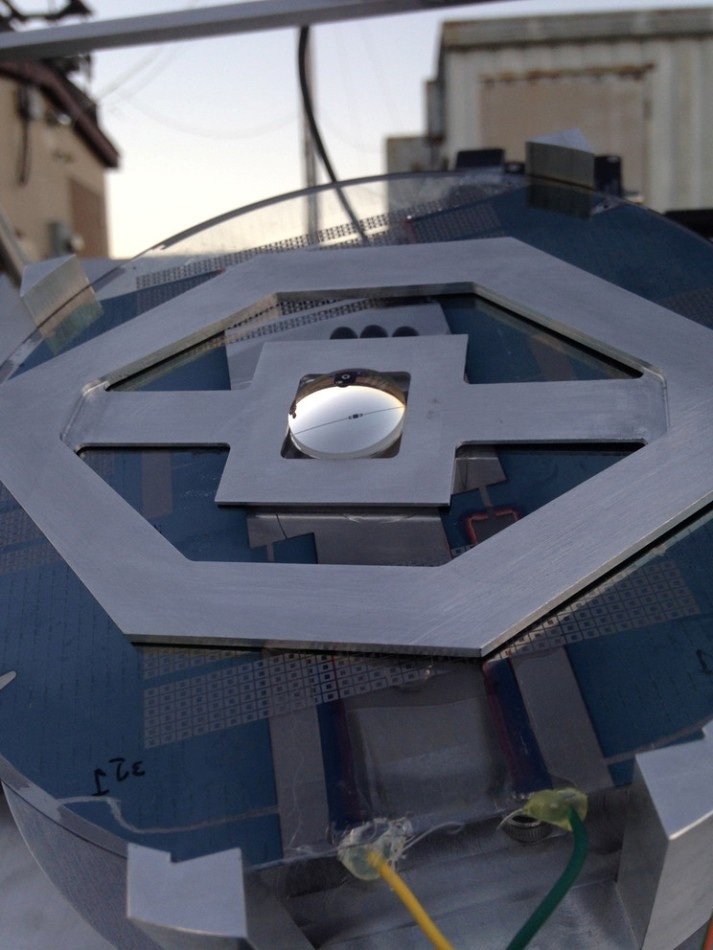Jul 18 2017
In a head-to-head competition, a concentrating photovoltaic system with embedded microtracking can produce more than 50% extra energy daily than standard silicon solar cells, according to a team of Engineers who field tested a prototype unit over two sunny days in Fall last year.
 The concentrating photovoltaic system showing the top lenslet; the little black square visible near the middle is the solar cell and the lines running away from it are the contact wires. (Image: Giebink lab)
The concentrating photovoltaic system showing the top lenslet; the little black square visible near the middle is the solar cell and the lines running away from it are the contact wires. (Image: Giebink lab)
Solar cells used to be expensive, but now they're getting really cheap. As a result, the solar cell is no longer the dominant cost of the energy it produces. The majority of the cost increasingly lies in everything else — the inverter, installation labor, permitting fees, etc. — all the stuff we used to neglect.
Chris Giebink, Charles K. Etner Assistant Professor of Electrical Engineering, Penn State
This transforming economic landscape has placed a premium on high efficiency. Contrary to silicon solar panels, which presently rule the market at 15 to 20% efficiency, concentrating photovoltaics focus sunlight onto smaller, but a lot more efficient solar cells like those used on satellites, to enable total efficiencies of 35 to 40%.
Existing CPV systems are large — the size of billboards — and in order to track the sun during the day, they have to rotate. These systems function well in open fields with plentiful space and lots of direct sun.
What we're trying to do is create a high-efficiency CPV system in the form factor of a traditional silicon solar panel.
Chris Giebink, Charles K. Etner Assistant Professor of Electrical Engineering, Penn State
To achieve this, the Researchers embed miniature multi-junction solar cells, approximately half a millimeter square, into a sheet of glass that slides between two plastic lenslet arrays. The entire setup is about 2 cm thick and tracking is carried out by sliding the sheet of solar cells laterally between the lenslet arrays while the panel stays fixed on the roof. A whole day's worth of tracking requires roughly 1 cm of movement, which is virtually undetectable.
Our goal in these recent experiments was to demonstrate the technical feasibility of such a system. We put together a prototype with a single microcell and a pair of lenses that concentrated sunlight more than 600 times, took it outdoors and had it automatically track the sun over the course of an entire day.
Chris Giebink, Charles K. Etner Assistant Professor of Electrical Engineering, Penn State
As the team wanted to know precisely how much direct and diffuse sunlight there was during the test, they set up at the Russell E. Larson Agricultural Research Center at Penn State where there is a National Oceanic and Atmospheric Administration Surface Radiation monitoring site.
Graduate Students Jared Price and Alex Grede collaborated together with Post-Doctoral Researcher Baomin Wang to test the system over two sunny days from dawn to dusk right in conjunction with a commercial silicon solar cell.
The Researchers report in the July 17th issue of Nature Energy that the CPV system realized 30% efficiency, compared to the 17% efficiency of the silicon cell. All together over the whole day, the CPV system yielded 54% more energy than the silicon and could have realized 73% if microcell heating from the intense sunlight had been avoided.
According to Giebink, this embedded tracking CPV technology would be ideal for areas with copious amounts of direct sunlight, such as Southwestern U.S.A. or Australia.
Giebink emphasizes that huge challenges are still present with regards to scaling the system to larger areas and proving that it can function reliably over the long term, but he remains hopeful.
Giebink added, "With the right engineering, we're looking at a step-change in efficiency that could be useful in applications ranging from rooftops to electric vehicles — really anywhere it's important to generate a lot of solar power from a limited area."
Other Researchers involved in this research from Penn State are Jared Price and Alex Grede, Graduate Students in Electrical Engineering, and Baomin Wang, Postdoctoral Scholar in Electrical Engineering, all first Authors; Michael Lipski, Undergraduate Student in Electrical Engineering; and Chris Rahn, Professor, Greg Brulo, Graduate Student and Xiaokun Ma, Graduate Student, all in Mechanical Engineering.
Researchers from other institutions include Brent Fisher and Scott Burroughs, Semprius Inc.; Kyu-Tae Lee and John A. Rogers, Department of Materials Science and Engineering; and Junwen He and Ralph G. Nuzzo, Department of Chemistry, all at University of Illinois at Urbana-Champaign.
This research was supported by the Advanced Research Projects Agency-Energy and the National Science Foundation.